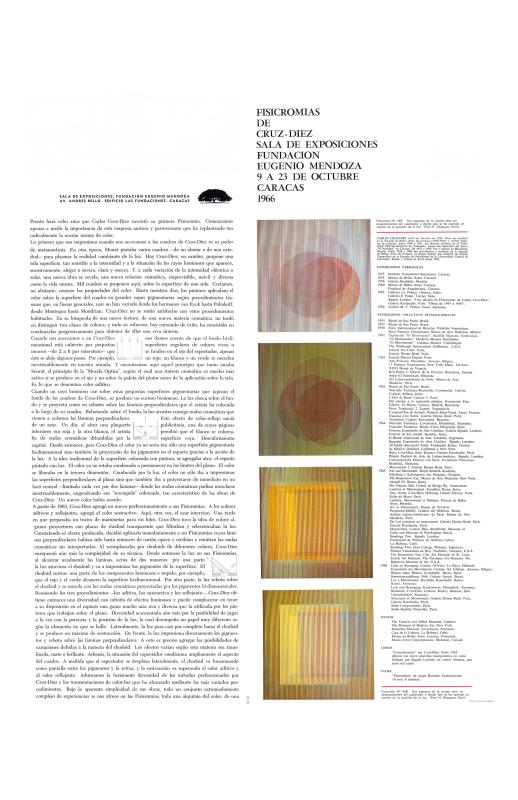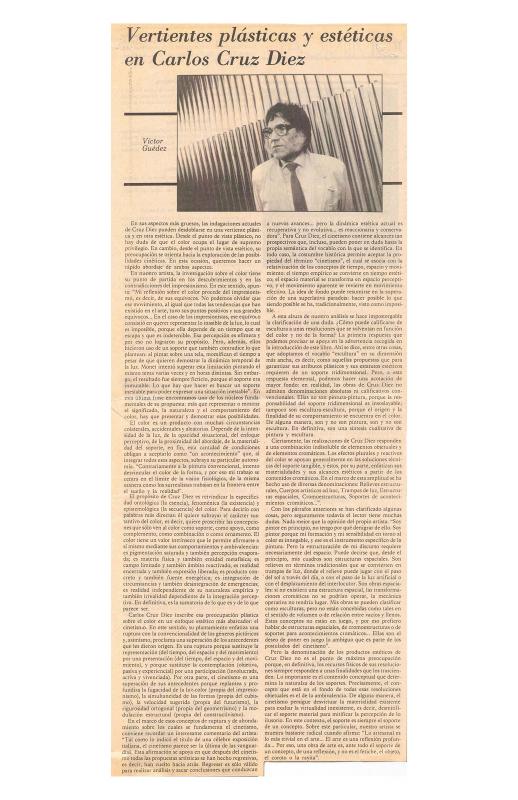The Colombian journalist and writer Plinio Apuleyo Mendoza (b. 1932) interviews the artist Carlos Cruz-Diez (b. 1923) in Paris. Mendoza introduces this paradigmatic Venezuelan Kinetic artist and explains that they are in his atelier (at 23, rue Pierre Semard, in the 9th arrondissement), which had once been a butcher shop but is now full of tools and wooden planks. The Colombian writer then describes Cruz-Diez as though he were someone in a novel: a small, deliberate man “with splendid sideburns, like a character out of Dickens or a Jacobin coachman.” Unlike some of Cruz-Diez’s other interviews, this one does not focus on the technical aspects of his work in the realm of color. Mendoza is a journalist, and gets him to talk about a range of interesting subjects, a strategy that adds a great deal of value to this document.
At Mendoza’s request, Cruz-Diez responds to the comments Marta Traba made in her book Mirar en Caracas: Crítica de Arte (Caracas: Monte Ávila Editores, 1974), in which she accuses the “Venezuelan Kinetic artists” of producing neutral art that does nothing to change reality. She makes a distinction between politics and art, and identifies the “purists” who see trickery in any government action aimed at promoting art in the street. Cruz-Diez also answers Traba’s comments about “the scope” of a work of art as a medium through which to change society. He states that—during his early years as a politically committed painter devoted to the portrayal of social realism—he never managed to change economic conditions in his country, no matter how often he painted scenes that compared the poverty of shanty towns with luxurious buildings.
Cruz-Diez mentions a letter in which José Clemente Orozco expressed his frustration and admitted that his murals were never able to change the fate of the Mexican people. Referring to criticism concerning a dependence on foreign ideas, Cruz-Diez agrees that artists must look beyond them and reject the mechanisms of any dependence, whether ideological or cultural. He emphasizes the fact that Kinetic art was originally conceived and developed by Latin Americans. “Soto, Le Parc, and I” he claims “have been copied by the French, the Germans, by everyone.” Cruz-Diez also explains where he thinks Venezuelan artists should go after Kinetic art.
To read more about the work of the artist Carlos Cruz-Diez, see the essay by Jean Clay “(Untitled) [Pronto hará ocho años que Carlos Cruz-Diez...] = [Voici bientôt huit ans que Carlos Cruz-Diez…]” [doc. no. 858602]; and the article by Víctor Guédez “Vertientes plásticas y estéticas en Carlos Cruz-Diez” [doc. no. 857000].


